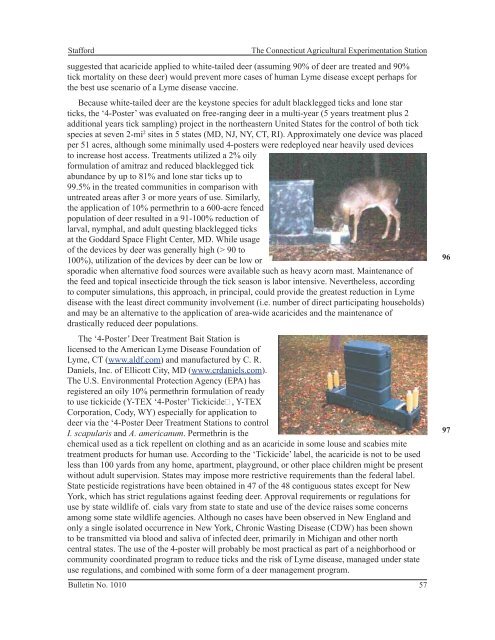Dr. Stafford Tick Management Handbook - Newtown, CT
Dr. Stafford Tick Management Handbook - Newtown, CT
Dr. Stafford Tick Management Handbook - Newtown, CT
Create successful ePaper yourself
Turn your PDF publications into a flip-book with our unique Google optimized e-Paper software.
<strong>Stafford</strong>The Connecticut Agricultural Experimentation Stationsuggested that acaricide applied to white-tailed deer (assuming 90% of deer are treated and 90%tick mortality on these deer) would prevent more cases of human Lyme disease except perhaps forthe best use scenario of a Lyme disease vaccine.Because white-tailed deer are the keystone species for adult blacklegged ticks and lone starticks, the ‘4-Poster’ was evaluated on free-ranging deer in a multi-year (5 years treatment plus 2additional years tick sampling) project in the northeastern United States for the control of both tickspecies at seven 2-mi 2 sites in 5 states (MD, NJ, NY, <strong>CT</strong>, RI). Approximately one device was placedper 51 acres, although some minimally used 4-posters were redeployed near heavily used devicesto increase host access. Treatments utilized a 2% oilyformulation of amitraz and reduced blacklegged tickabundance by up to 81% and lone star ticks up to99.5% in the treated communities in comparison withuntreated areas after 3 or more years of use. Similarly,the application of 10% permethrin to a 600-acre fencedpopulation of deer resulted in a 91-100% reduction oflarval, nymphal, and adult questing blacklegged ticksat the Goddard Space Flight Center, MD. While usageof the devices by deer was generally high (> 90 to100%), utilization of the devices by deer can be low orsporadic when alternative food sources were available such as heavy acorn mast. Maintenance ofthe feed and topical insecticide through the tick season is labor intensive. Nevertheless, accordingto computer simulations, this approach, in principal, could provide the greatest reduction in Lymedisease with the least direct community involvement (i.e. number of direct participating households)and may be an alternative to the application of area-wide acaricides and the maintenance ofdrastically reduced deer populations.The ‘4-Poster’ Deer Treatment Bait Station islicensed to the American Lyme Disease Foundation ofLyme, <strong>CT</strong> (www.aldf.com) and manufactured by C. R.Daniels, Inc. of Ellicott City, MD (www.crdaniels.com).The U.S. Environmental Protection Agency (EPA) hasregistered an oily 10% permethrin formulation of readyto use tickicide (Y-TEX ‘4-Poster’ <strong>Tick</strong>icide , Y-TEXCorporation, Cody, WY) especially for application todeer via the ‘4-Poster Deer Treatment Stations to controlI. scapularis and A. americanum. Permethrin is thechemical used as a tick repellent on clothing and as an acaricide in some louse and scabies mitetreatment products for human use. According to the ‘<strong>Tick</strong>icide’ label, the acaricide is not to be usedless than 100 yards from any home, apartment, playground, or other place children might be presentwithout adult supervision. States may impose more restrictive requirements than the federal label.State pesticide registrations have been obtained in 47 of the 48 contiguous states except for NewYork, which has strict regulations against feeding deer. Approval requirements or regulations foruse by state wildlife of. cials vary from state to state and use of the device raises some concernsamong some state wildlife agencies. Although no cases have been observed in New England andonly a single isolated occurrence in New York, Chronic Wasting Disease (CDW) has been shownto be transmitted via blood and saliva of infected deer, primarily in Michigan and other northcentral states. The use of the 4-poster will probably be most practical as part of a neighborhood orcommunity coordinated program to reduce ticks and the risk of Lyme disease, managed under stateuse regulations, and combined with some form of a deer management program.Bulletin No. 1010 579697











